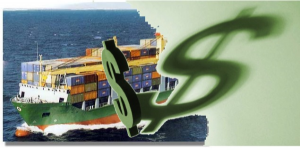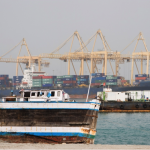Is THE Alliance in Trouble?
 THE Alliance members are “falling further behind in the megamax vessel stakes,” Alphaliner was quoted as saying in an article by Mike Wackett in the Loadstar.
THE Alliance members are “falling further behind in the megamax vessel stakes,” Alphaliner was quoted as saying in an article by Mike Wackett in the Loadstar.
The headlining point of the article was that the carrier alliance’s falling behind in the megamax vessel stakes could cost THE Alliance $500 more per TEU than the carrier alliances its competing with. Wackett writes:
THE Alliance could find itself on the wrong side of a $500 per teu cost differential on the key Asia-North Europe trade due to its members’ failure to order more ultra-large container vessels (ULCVs), according to new analysis from Alphaliner.
…
Alphaliner notes that, including its orderbook, THE Alliance will only have 12 ships of 18,000-20,000 teu – six operated by Hapag-Lloyd and six by MOL. This compares with 62 ULCVs for the 2M and 51 for the Ocean Alliance.
As regular readers of this blog know, ocean shipping in the international shipping industry is now dominated by the three alliances, 2M, Ocean Alliance, and THE Alliance, brought up by Wackett above.
To survive the slim profit margins and overcapacity of ocean shipping, carrier alliances and megaships have become something of a necessity for carriers. Carriers need the assets of alliances and larger ships to compete in the international market. These assets bring down carrier costs on importing and exporting shipping containers of goods for shippers.
Competition between carriers is fierce. Overcapacity was a huge factor in creating record low freight rates in ocean shipping over the last couple years. However, freight rate wars between carriers also played a major role.
Of late, carriers have been able to raise freight rates and sustain those higher rates; however, carriers are far from safely profitable, moving into the future.
A $500 per TEU cost differential between carrier alliances is not only significant, it’s vast.
Wacket’s article brings up THE alliance members Yang Ming and Hapag-Lloyd’s financial issues, making them too strapped for cash, and NYK, MOL, and K-Line’s merging, making them too preoccupied, as reasons THE Alliance will not be able to bring their megaship fleet up to the level of the other two major carrier alliances.
If THE can’t find another way to reduce costs, the alliance could be in serious trouble, especially if another rate war breaks out. If THE Alliance ends up struggling to compete with 2M and Ocean Alliance, another carrier alliance shakeup could come.
Members of another alliance may find it beneficial to extend membership to a THE member, making THE even more precarious. THE members certainly cannot afford to find themselves without an alliance.
The trend for ocean carriers has shifted from acquiring megaships to acquiring competing shipping companies. If THE Alliance were to dissolve without its members realigning in other alliances, it’s hard to imagine that a member or two wouldn’t get picked off.
Perhaps, instead of the industry being dominated by three alliances, shippers will see it dominated by only two in the not so distant future.
Let’s hope the ever shrinking carrier competition in the international shipping industry doesn’t fall that low anytime soon.




